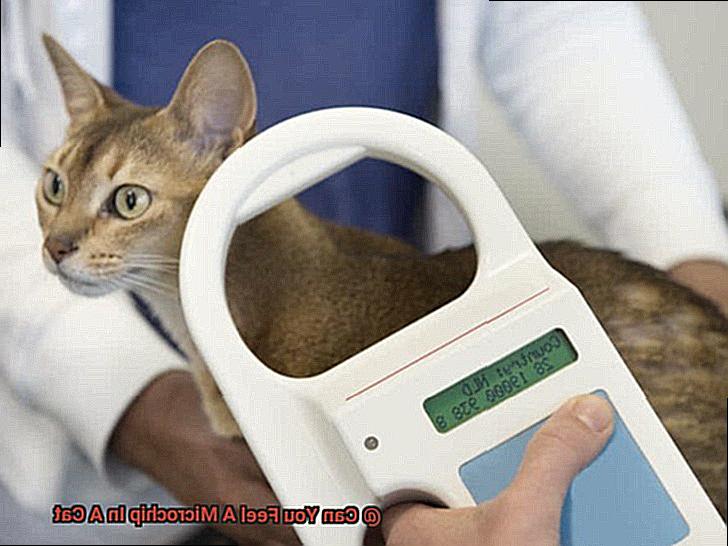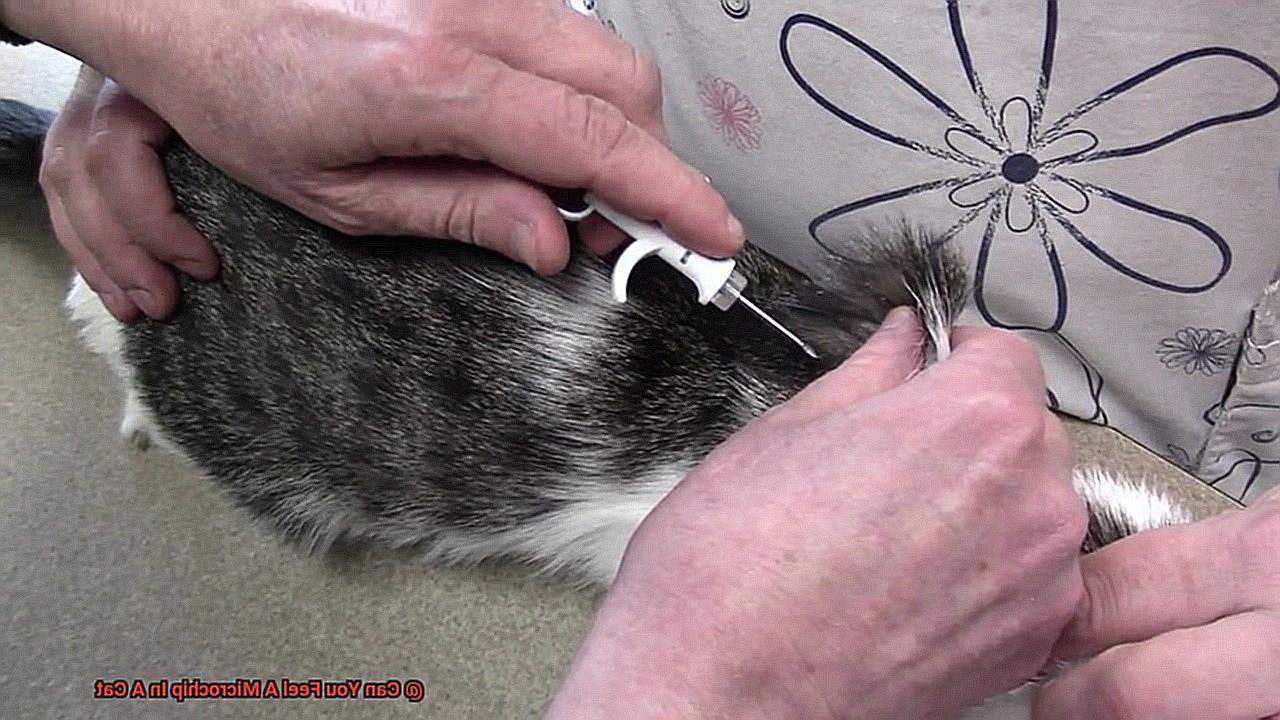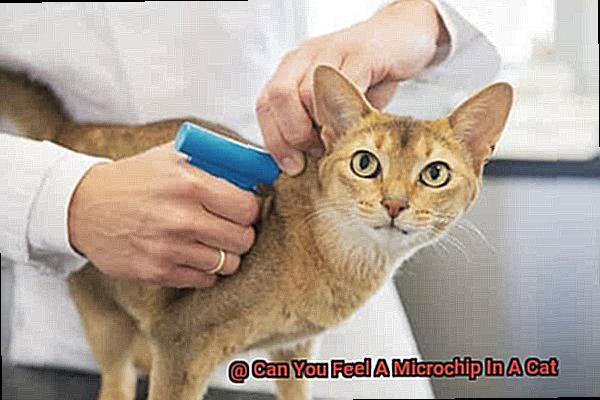Do you ever wonder if your cat has a microchip? It’s a common question for pet owners, and the answer is yes. Cats can be implanted with a very small chip – about the size of a grain of rice – just beneath their shoulder blades’ skin.
But can you feel it? No, you can’t feel a microchip in your cat.
The chip is designed to be as unobtrusive as possible so that it won’t cause any pain or irritation to your pet. So why get one implanted?
Microchips are incredibly useful if your pet were ever lost or stolen. Each chip has an ID number unique to your animal, which can be checked by vets or animal shelters if they find them.
This makes it much easier to locate missing cats with their owners, reducing the number of strays on the streets. Microchipping also helps protect cats from robbery and other forms of animal cruelty.
Potential robbers will know that cats with microchips can be traced back to their rightful owner, making them less likely to take them without authorization. In conclusion, although it’s not possible to feel a microchip in your cat’s body, there are some great reasons why getting one implanted could be beneficial for them.
Not only does it provide peace of mind for owners of pets that have been lost or stolen, but it also helps shield cats from harm and guarantees that they will always have someone looking out for them if they ever go astray from home.
Can You Feel a Cat’s Microchip?
It may be possible, but it depends on several factors.

Microchips are tiny electronic devices the size of a grain of rice that are implanted between a cat’s shoulder blades using a hypodermic needle. Some pet owners claim to be able to detect the microchip as a small lump or bump under the skin.
The ability to feel the chip largely depends on the size and weight of your cat, as well as their coat length. If they are thin or have a short coat, it may be easier to feel the microchip.

To accurately identify whether your cat has been microchipped, you should use a scanner available at most veterinary clinics, animal shelters and rescue organizations.
Factors That Affect Whether or Not You Can Feel a Microchip
The ability to feel a microchip in a cat’s body is determined by several factors.
From the chip’s location and the breed of your cat to its weight and scar tissue, these variables can all play a role in whether or not you can detect the presence of the microchip. Typically, chips are inserted between a cat’s shoulder blades under their skin.
If this area is closer to the surface, it may be easier for you to feel than if it were situated deeper in their muscle tissue. The breed of your cat also matters.

Hairless cats such as Sphynx and Peterbalds have little fur covering them up, making it simple for us to detect the chip with our fingertips. On the other hand, long-haired breeds such as Maine Coons and Persians have thicker fur that makes it more difficult for us to sense its presence.
Weight is another factor that influences our ability to feel a microchip. Overweight cats tend to have thicker skin and layers of fat that make it challenging for us to locate the chip underneath.

On the contrary, cats that are underweight may have less protection over their chip, making it easier for us to track its presence with our hands. Finally, scar tissue can form around a microchip site during implantation if inflammation or irritation occurs.
Even if you cannot feel your cat’s microchip with your hands, it is still essential that they have one and that their contact details are registered with it.
How to Find a Cat’s Microchip
When it comes to keeping your beloved cat safe, one of the best things you can do is to microchip them. Microchipping involves inserting a tiny grain-sized chip under the skin of cats between their shoulder blades as an identification device in case they are missing or stolen. But how do you find out if your cat has a microchip?
The good news is that there are several ways to determine your cat’s microchip status. The most common way to find the chip is to feel for it with your fingertips. Simply run your fingers over the shoulder blades and feel for a tiny, hard object just below the surface.
It may take some patience, but with some mild pressure, you should be able to feel the microchip.
If feeling for the chip doesn’t work, a different alternative is to use a handheld scanner. Many animal shelters and veterinary clinics have scanners that can quickly and accurately determine whether or not there is a microchip present in your cat’s body. Alternatively, you can buy a scanner online if you prefer.
And lastly, if all else fails, you should always check your cat’s medical records or call the breeder or rescue group from which you adopted them. They may have already embedded a microchip in your cat before they were adopted out to you, so this information should be included in their records.

Overall, finding out if your cat has a microchip isn’t always straightforward, but with these tips and tricks it should be much less difficult.
Is it Painful for Cats to Get Microchipped?
The process of microchipping your cat may sound intimidating, but it is actually a quick and painless procedure.
During the process, a veterinarian or trained technician will use a small needle to inject a tiny, rice-sized chip under the cat’s skin, usually between the shoulder blades. The cat may only experience a momentary pinch or sting – similar to receiving a vaccination – and any mild soreness at the injection site should dissipate within a day or two.
It provides pet owners with peace of mind knowing that their beloved felines can be identified quickly and easily if they ever become lost or stolen, ensuring that they are always found and returned home safely.
Other Ways to Identify Your Cat if You Cannot Feel the Microchip
The thought of a lost cat is enough to send any pet owner into a panic.
Fortunately, there are ways to identify them if they go missing. Microchipping is the most reliable method, but what if you can’t feel the microchip?
There are other ways to find your feline friend. One of the easiest things to do is make sure your cat has a collar with a tag that includes all relevant information such as their name, address, and phone number.
This will enable whoever finds them to contact you quickly. It’s also important to take note of any unique physical traits such as their coat color, eye shape, or fur patterns.
When searching for your cat, this information can be invaluable. Social media can also be an extremely useful tool in locating lost cats.
Benefits of Having a Cat Microchipped
The thought of a beloved cat going missing can be heartbreaking, but microchipping offers an ideal solution to reunite with them.
Microchipping is an electronic device, usually found just under a cat’s skin between the shoulder blades, that contains a unique ID number that can be read by a microchip reader and used to identify the cat and its owner. This method of identification is permanent and will remain with the cat for life, unlike collars and tags which can easily get lost or removed.
Owners who are worried about their cats running away and not being able to find their way home are also given peace of mind. In addition, microchipping is much more reliable than tattooing which can fade or become distorted over time, and it doesn’t cause any pain or discomfort to your feline friend.
It’s important to note that in many countries it is a legal requirement to microchip cats. For example, in the UK all cats must be microchipped by the time they are eight weeks old; failure to comply with this law can result in a fine of up to 5000 pounds.
The benefits of having your cat microchipped are clear; it increases the chances of being reunited with a lost pet, provides a permanent form of identification, and is a more reliable and affordable option than other forms of identification.
How Much Does it Cost to Get a Cat Microchipped?
The cost of microchipping your cat will depend on several factors such as location, the veterinary facility, and any additional services included. Generally speaking, it will range from $25 to $50 in the United States, with some clinics charging up to $100.
Be sure to ask what exactly is included in the price before making a decision. Although the initial cost may seem like a lot, consider the potential risks and expenses associated with losing your pet.
A microchip can help reunite you with your lost pet and may even be required by certain cities in order to comply with local regulations. Plus, animal shelters or rescue groups may offer microchipping services at a discounted rate or even free of charge if you are unable to afford it.
aGthVJlMEIk” >
Conclusion
Microchipping your cat is the best way to ensure their safety and protection.
It can give pet owners peace of mind, knowing that their beloved felines will be found quickly and safely if they ever get lost or stolen. Plus, it helps prevent cats from harm and guarantees that someone will always be looking out for them if they go missing from home.
The process is quick and painless, but it may cost you between $25 and $50 in the United States. In several countries, such as the UK, microchipping cats is a legal requirement by the time they reach eight weeks old.
Collars with tags containing name, address and phone number are highly recommended; social media can also be useful; and don’t forget to check with local animal shelters.







